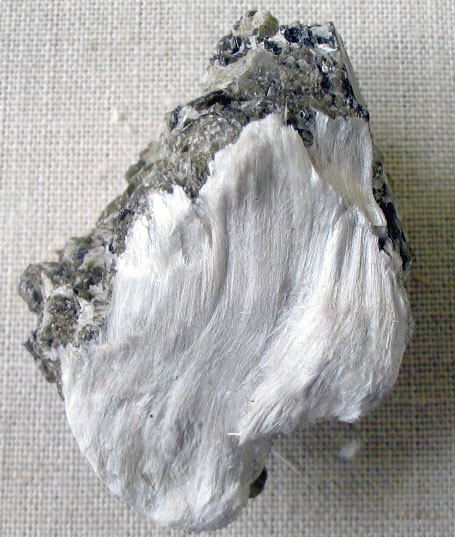
ASBESTOS.
A SMALL specimen of the above-named mineral lies beside me as I write. It looks like cotton just taken from the plant. A close examination, however, shows the difference between the two articles.
Asbestos is gray, while cotton is white; the -fibers of the former are short, of the latter, long; in the delicate threads of the mineral, we find slender, black crystals and tiny balls resembling shot, while in the cotton no such particles exist.
This particular specimen of asbestos was given me by a girl of twelve years. She received it from a gentleman who found it in an iron mine near Scranton, Penn., where it abounds.
Many varieties of this peculiar-looking mineral are found in different portions of the United States. In its finest and rarest forms, it is called amianthus, and can only be obtained from the older crystallized rocks.
Savoy and Corsica produce the best amianthus; but some good specimens of it have been brought from the Pyrenees, the Alps, the mountains of Silesia, New South Wales, and from parts of North America.
Amianthus has been known in all ages and in all countries. The ancients prized it, as we now do asbestos, because it would not burn. They wove it into cloth, and used it for shrouds in which, to wrap the bodies of their dead.
This cloth was first prepared by combining the fibers of the amianthus with those of flax. It was then exposed to the heat of a powerful furnace.
By this means, the flax in the cloth was destroyed.
Many of the ancient natives practiced what we now term cremation. They burned instead of burying the bodies of their dead. Wrapped in fireproof shrouds Of amianthine cloth, they placed these bodies on the tops of funeral piles, sometimes built of the costliest and most fragrant kinds of wood. They then applied the torch to the fagots; and the flames, gradually creeping up, would consume the body, and reduce it to ashes. But, protected by their amianthine robes, these sacred ashes could afterward be collected, and placed in the beautiful memorial urns prepared for their reception.
Coming down a little later in the history of the world, we find this same amianthine cloth manufactured into towels, handkerchiefs, gloves, dresses, and even into entire suits of clothes. These, to be purified, needed only to be thrown into the fire.
An amusing story is told of Charlemagne. This wise and witty monarch lived about A. D. 800. He was a powerful emperor, reigning in great state over both Germany and France, and was called the Caesar (Kaiser) of the West. It is said that he had an amianthine cloth, which he used to have spread upon his banqueting table. After the feasting was well over, for the further entertainment of the guests—so runs the legend—he would snatch the cloth from the table and throw it into the fire. To their utter amazement, this cloth would come forth from the flames cleansed, but not consumed.
In these modern times, asbestos is principally put to practical uses, such as in the construction of fireproof safes, floorings, and roofs. Paper has been made from it, and would prove very valuable for important documents, were it not too fragile and tender.
I prize my little specimen, not only as a curiosity, but as another instance of the manifold and marvelous works of the great Creator, and of the fitness of those creations to the varied wants of man.
Adeline Wardell.